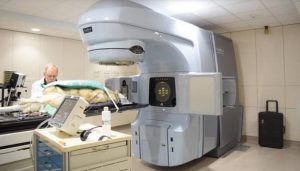
Sampson, a 10 year old Husky, lies sedated on a table in the new radiation treatment room at the Iowa State Hixson-Lied Small animal Hospital. He received his third radiation treatment for a nasal tumor. Photo by Kylee Mullen/ Ames Tribune.
By Kylee Mullen, Staff Writer kmullen@amestrib.com
Posted May 18, 2019 at 12:01 AMUpdated May 18, 2019 at 7:49 PM
Sampson, a 10-year-old husky, received his final radiation treatment last week at the Iowa State University Hixson-Lied Small Animal Hospital. As he lay sedated on a table in the new treatment room, his oncology team celebrated his upcoming “graduation.”
He had undergone two treatments in the facility previously for a nasal tumor. According to Chad Johannes, an assistant professor of veterinary clinical services, Sampson would not have been able to receive his treatment if it wasn’t for a new treatment option the hospital opened earlier this spring.
“A nasal tumor isn’t uncommon for dogs to get, especially for long-nose breeds like huskies. Since we can’t get in surgically, we have to use radiation,” Johannes said. “For a lot of tumors, radiation is the treatment of choice. We didn’t have this access before, so having this technology here is so important for our pets in the area.”
Known as stereotactic radiation therapy (SRT), the treatment technique delivers high-intensity radiation with “down to the millimeter” precision without significantly affecting the healthy tissue surrounding the tumor. SRT can drastically reduce the side effects associated with radiation therapy, as well as the number of treatments patients must receive.
Johannes said, prior to offering the treatment in February, regional access to radiation treatment facilities was limited to the University of Missouri, University of Minnesota and University of Wisconsin. The nearest SRT sites were at Colorado State University, Fort Collins, and a private practice in Milwaukee.
Ames now has the only facility in Iowa, Nebraska, South Dakota, and the Kansas City metropolitan area. That makes SRT a more accessible option for clients throughout the Midwest, who otherwise would not be able to travel a great distance for the treatments.
“For many clients, it is pretty challenging to make that drive, leave their pets there for a period of time, and it really keeps clients from pursuing that therapy,” Johannes said. “This allows us at Iowa State to provide these treatment options that were not previously available and, hopefully, give our patients more time with their families and a good quality of life.”
During Sampson’s treatment, radiation therapists and an anesthesiologist ensured he was fully sedated and anesthetized before positioning him on the table. It is important for the patient to remain completely still in the exact position they had been in during previous treatments so the high-dose radiation can be delivered to the exact same spot. Once positioned, the staff moves into an adjacent room where a CT scan is taken of the tumor.
Drema Lopez, a radiation therapist at ISU College of Veterinary Medicine, then goes over the CT scan to make sure the patient is in the proper position and the treatment is being directed to the right place without affecting surrounding tissue. She also looks for any changes in the tumor’s growth.
“With Sampson, we were doing the treatment really close to his eyes, and that is something where I am going to make sure we are not including anything that the radiation oncologist doesn’t want in the treatment,” Lopez said. “We can also see whether there is tumor growth, which I would point out to the radiation oncologist to see if we need to redesign their treatment plan.”
After the team verifies the pet in the right position, the large radiation machine rotates into place and a pair of heavy doors close to protect anyone outside of the room from radiation. The technicians monitor the patient using a system of cameras and monitors while the machine delivers radiation to the tissues.
It takes a matter of minutes to deliver the treatment before the doors slide open, and the technicians take the pet off of the table and recover it from anesthesia. The pet will either go back home with their families later in the day or the next morning.
“There are a lot of people out there who consider their pets as part of their family, and pets have become such an important part of our lives that we definitely want to do what we can for them just like we would any other member of our family. That’s why it’s so important to offer this service to people that they wouldn’t have been able to get otherwise,” Lopez said.
Since the hospital started offering the treatment option in February, the team has treated 16 pets including dogs, cats and a pet rat. The treatment will ideally extend their lifespan from a matter of months to a year, though each case is different.
“We are fortunate to have this technology here, as it allows us to bring it to our patients not just in Ames, but in all of Iowa and in other states. We are really well positioned to be accessible to a lot of clients,” Johannes said. “It can oftentimes extend the (patient’s) life and give them a better quality of life. Overall, for many tumor types, we can have a positive impact.”
Johannes said SRT can treat a wide range of tumors and pet owners should talk with their primary veterinarian if they are interested in radiation therapy for their pet. Treatment costs range from $2,500 to $9,000 and vary widely depending on the patient’s unique circumstances.
“I always tell patients that they know their pet best, and if they notice any changes in their pet they should see their primary care veterinarian. If their pet is diagnosed with cancer, talk to your vet about options that may be available and we are always here to help,” Johannes said.
Source: From The AMES Tribune








